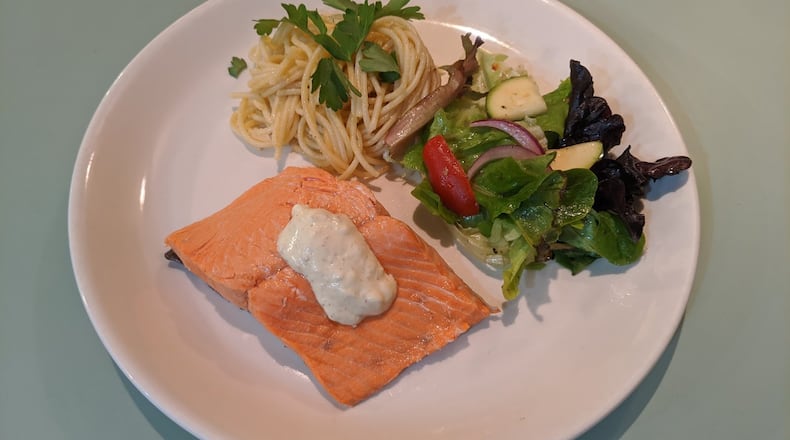“I am stumped about salmon,” wrote AJC reader Lisa McGee of Cumming. “There are so many different kinds and I don’t have a clue how they’re different or which kind I should get.”
Atlanta chef Doug Turbush is more of a salmon expert than me. In early 2018, his Marietta restaurant Drift Fish House & Oyster Bar became the first Georgia restaurant to partner with the Monterey Bay Aquarium Seafood Watch program.
Drift took the guesswork out of ordering because every fish or seafood item on the menu is an environmentally responsible choice, adhering to the “Best Choice” or “Good Alternative” ratings determined by Seafood Watch.
“Seafood is a really confusing topic,” Turbush conceded.
Turbush has sourced salmon from Denmark’s Faroe Islands, Verlasso salmon raised in the Patagonia region of southern Chile and Atlantic salmon raised an ocean away in Vancouver Island.
“You have to ask yourself, What are the long-term effects of raising Atlantic salmon in the Pacific?” he commented.
It can be difficult for the average consumer to stay informed about responsibly managed fisheries around the globe.
The solution for the home cook: purchase from shops who source as responsibly as possible.
For farm-raised salmon, Turbush recommended patronizing Atlanta Fish Market in Buckhead, Heywood’s Provision Company in Marietta and Whole Foods. The latter also offers wild-caught salmon. The flavor is superior to farm-raised, but it comes at a premium.
Whole Foods takes most of the guesswork out of choosing fish and seafood by labeling its wild-caught products with either a seal of approval from the Marine Stewardship Council (the leading certification program for sustainable seafood); a green stamp indicating that it has been sourced “from well-managed fisheries” and “caught in ways that cause little harm to habits or other wildlife”; or a yellow seal denoting that the fish hails “from fisheries where there are some concerns with how species are caught or managed.” Farm-raised fish and seafood sold at Whole Foods is third-party verified to meet the store’s standards for responsibly farmed product.
As for how to cook that fish: Salmon is versatile. Its high-fat content makes it a forgiving fish, as long as you don’t overcook it, Turbush said. He recommended cooking it over high heat in a sizzling hot pan to lock in the moisture. His other preferred methods are steaming or poaching.
My favorite poached salmon preparation is an adaptation of a recipe card I picked up more than 20 years ago from the seafood counter at a Meijer grocery store in Michigan. Poached Salmon with Mustard Sauce comes together in minutes. The higher the quality of the fish, the better the dish. And, like that now stained and pen-marked recipe card promises, it is “elegant but so easy!”
Recipe: Poached Salmon with Mustard Sauce
- 1 tablespoon nonfat plain yogurt
- 1 tablespoon sour cream
- 1 tablespoon mayonnaise
- 1 teaspoon yellow mustard
- 1/2 teaspoon grated fresh ginger
- 1/4 teaspoon honey
- 1 1/2 pounds salmon fillet, cut into 4 pieces
- Minced fresh chives or parsley, for garnish
- In a small bowl, combine the yogurt, sour cream, mayonnaise, mustard, ginger and honey. Set aside.
- Rinse salmon and pat dry. Bring about 2 inches water to boil in a large pan or wok. Add fish, and reduce heat so water just simmers. Simmer until fish is just slightly translucent in the center, 8 minutes for 1-inch-thick fillet.
- Remove from the pan, let drain and gently pat dry. Divide among 4 plates, spoon sauce over each portion and garnish with minced chives or parsley. Serves 4.
Nutritional information
Per serving: 227 calories (percent of calories from fat, 36), 34 grams protein, 1 gram carbohydrates, trace fiber, 9 grams fat (1 gram saturated), 90 milligrams cholesterol, 152 milligrams sodium.
RELATED:
Read more stories like this by liking Atlanta Restaurant Scene on Facebook, following @ATLDiningNews on Twitter and @ajcdining on Instagram.
About the Author
Keep Reading
The Latest
Featured



